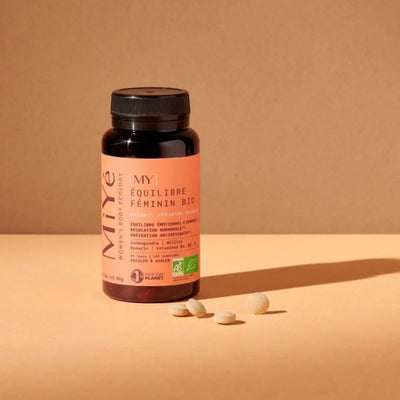
Is it normal to have thick periods and what to do?
Verified on 7/28/2025
Welcome to Gapianne! 👋
Here, we guide women towards appropriate solutions for all issues related to their gynecological health and intimate well-being, thanks to a personalized support program.
Menstruation is a natural phenomenon that most women experience every month, but it can vary considerably from woman to woman and even from cycle to cycle. Among the various characteristics of menstruation, the consistency of the flow is sometimes a source of concern. Have you ever noticed a thicker , or even clotted , flow during your period? If so, you've probably wondered if this is normal and what actions you can take. In this article, we'll explore the causes of thick periods , debunk some misconceptions, and provide you with tips for dealing with this phenomenon with confidence. Enjoy!
What is the “normal” consistency of periods?
First of all, we think it's interesting to look at the somewhat subjective notion of "normal periods" before discussing heavy periods. Indeed, every person with a uterus is unique and can have different menstrual experiences. However, generally speaking, a "normal" menstrual flow goes through several consistencies throughout the menstrual period.
The start of menstruation:
At the beginning of the menstrual cycle, some women may initially experience very light bleeding, often referred to as "spotting." This bleeding can range in color from pink to light brown. Typically, as menstruation begins, the flow increases, usually becoming a brighter red color and noticeably thinner in consistency.
The middle of the rules:
The middle of the menstrual cycle is when the flow is heaviest. The shades of blood can vary from bright red to darker red, often accompanied by a slightly thicker consistency . For many menstruators, it is not uncommon to observe the presence of small clots , especially during these days when the flow is at its peak.
The end of the rules:
As your period nears its end, your discharge often thickens , becoming viscous or even slimy. The color of your discharge may change to brown or even black. This darker color is usually a sign of older blood that is taking longer to clear from your uterus.
A quick reminder: these trends are general. What's "normal" for one woman may not be normal for another!
What are thick rules?
"Heavy periods" refers to the consistency of menstrual flow. There aren't really "types" of heavy periods, but rather characteristics or symptoms that can accompany thicker-than-normal periods. Here are some common symptoms associated with heavy periods :
Blood clots:
The presence of clots during menstruation is quite common, especially during heavier flow days. These clots are usually small pieces of endometrial tissue that break off. If the clots are large or very numerous, this may indicate heavier than normal bleeding.
Dark and almost "lumpy" menstrual periods:
A darker color, such as burgundy or almost black, and a lumpy consistency can be a sign of a thick period. This is often the result of the slow flow, allowing the blood to oxidize and thicken.
Heavy flow:
Although the amount of flow does not necessarily indicate its consistency, a heavy flow can sometimes be accompanied by a thicker period.
Also read: Which sanitary protection should I choose according to my period? >
What could be the causes?
There are several factors that can cause thicker periods . Let's take a look at what they are.
Hormonal imbalance:
Hormones, particularly estrogen and progesterone, play a crucial role in the menstrual cycle . An imbalance between these hormones can lead to changes in menstrual flow, including thickening of menstrual blood. For example, an excess of estrogen compared to progesterone can cause the endometrium (the lining of the uterus) to overgrow , leading to heavier and thicker periods.
🌈 On this subject, find Miyé's natural Hormonal Disorder treatment in the store, it regulates both emotional (stress, mood, etc.) and physical (hot flashes, cramps, etc.) disorders.
Uterine fibroids:
Fibroids are benign, non-cancerous, tumors that originate in the smooth muscle of the uterine wall. Their size, location, and number can vary greatly from one uterus to another. As fibroids increase in size or number, they can put pressure on the uterine wall or disrupt the normal endometrial layer. This disruption can lead to heavier bleeding during menstruation . In addition, the presence of fibroids can impair the normal contractility of the uterus, which can slow the flow of menstrual blood. When blood flows more slowly, it tends to clot, resulting in the formation of clots.
Endometriosis:
Endometriosis is a gynecological condition characterized by the growth of tissue similar to the endometrium (the inner lining of the uterus) outside the uterus. This ectopic tissue can develop on the ovaries, fallopian tubes, and other pelvic organs, creating lesions or nodules. One of the direct consequences of this disease is chronic inflammation, which, with each menstrual cycle, causes internal pain and bleeding. This internal bleeding, combined with inflammation, can lead to more painful and heavier menstrual periods . In addition, the inflammatory process and the presence of old blood can influence the consistency of menstrual flow, sometimes giving it a thicker texture and clots. It is essential to recognize these symptoms, because endometriosis, if left untreated, can affect the fertility and quality of life of affected women.
🌈 If you suffer from intense or even unbearable pain, we have two effective solutions to relieve your pain and allow you to return to an active life during your period: 20% CBD oil from Équilibre and the Bluetens period pain relief device . Thanks to the anti-inflammatory powers of CBD, many people suffering from endometriosis say that CBD oil makes a real difference in their daily lives and that they can no longer do without it!
As for the medical device, it allows you to naturally and instantly relieve pain linked to your menstrual cycles thanks to electrostimulation.
With these two, say bye bye to menstrual pain! Otherwise, discover all our natural solutions to relieve menstrual pain .
Endometrial polyps
Endometrial polyps are benign growths that develop from the inner lining of the uterus, known as the endometrium. Although they are usually non-cancerous, these polyps can disrupt the menstrual cycle in various ways. Their presence can, for example, cause irregular periods . In addition, they can promote heavier than normal periods. One reason is that these polyps, by bleeding themselves or by irritating the uterine wall, increase the overall volume of bleeding. This increased flow can, in turn, lead to the formation of clots , especially if the evacuation of blood is slowed. Monitoring such symptoms is crucial because, even if they are benign, it is sometimes necessary to remove these polyps to prevent possible complications.
Adenomyosis:
Adenomyosis is a gynecological condition characterized by the proliferation of endometrial tissue, normally confined to the uterine cavity, within the muscular wall of the uterus, called the myometrium. This abnormal infiltration often causes a thickening of the uterus . With each menstrual cycle, this ectopic tissue, like normal endometrium, responds to hormones by bleeding. However, being embedded deep within the muscular wall, this bleeding leads to inflammation and stretching of the uterus, causing intense menstrual pain. In addition, the presence of this tissue within the uterine muscle can contribute to a heavier menstrual flow , thus exacerbating painful symptoms. Recognizing and treating adenomyosis is essential to improve the quality of life of affected women.
Age-related changes:
Over time and with the natural hormonal fluctuations associated with aging, a woman's menstrual cycle can undergo noticeable changes. Particularly during the premenopausal phase—the transitional period before menopause—menstrual irregularities become common. This phase, which can last for several years, is marked by changes in hormone levels such as estrogen and progesterone. These fluctuations can lead to shorter or longer menstrual cycles, unexpected bleeding, or the absence of menstruation for several months. Additionally, many women report heavier periods, or even bleeding with clots, making the menstrual flow thicker. These changes, while natural, can be a source of concern and discomfort. It is therefore essential to discuss them with a healthcare professional to ensure proper follow-up and obtain advice on managing these symptoms.
Contraceptive drugs and devices:
The use of contraceptive medications and devices plays a significant role in regulating the menstrual cycle. In particular, medications that alter hormonal balance, such as the contraceptive pill, patches, or hormonal injections, can influence the duration, frequency, and consistency of periods . Similarly, intrauterine devices (IUDs), whether hormonal or copper, have an impact on menstrual flow . The hormonal IUD can reduce the amount of bleeding or even eliminate it completely, while the copper IUD can sometimes increase the amount of bleeding and cause more painful periods.
A pregnancy or miscarriage:
Pregnancy causes profound hormonal changes in a woman's body, which can sometimes result in unusual symptoms or disruptions to the menstrual cycle. A miscarriage, especially when it occurs very early in pregnancy, can go unnoticed. It may manifest as a late menstrual cycle that is heavier and thicker than usual. Bleeding may contain clots or fragments of tissue, which can be misinterpreted as a particularly heavy period. While it's natural to think of an abnormal period, these symptoms may actually be indicative of a miscarriage. Therefore, it is crucial, in case of doubt or significant changes in the menstrual cycle, to consult a healthcare professional to clarify the situation and receive appropriate support.
Clotting problems:
Clotting is a complex process that allows blood to change from a liquid to a semi-solid state to stop bleeding. People with clotting disorders have an imbalance in this mechanism, which can affect many aspects of their health, including the menstrual cycle. When blood does not clot properly, there may be increased clot formation during menstruation. As a result, these individuals may experience thicker menstrual flow, consisting of more or larger clots than normal. These manifestations can not only be worrisome but can also be associated with more painful or longer periods. Again, when faced with such irregularities, it is important to consult a specialist for a complete evaluation and treatment recommendations.
👉If you are concerned about the consistency of your period or if you notice significant changes, it is essential to consult a gynecologist or other healthcare professional to obtain an accurate diagnosis and appropriate advice.
When to see a doctor?
As we just mentioned, it's important to see a doctor . Especially if you notice a change in the consistency of your period, such as thicker periods or an increased presence of clots. Listening to your body is vital and can save you a lot of trouble. Here are some situations where it would be wise to see a doctor.
- Period duration and flow abundance: If your period is not only thick, but also much heavier than usual and lasts longer (e.g., more than 7 days).
- Severe pain: If you experience severe pelvic pain or cramps that are different or stronger than your usual menstrual cramps.
- Unusual symptoms: If you notice other unusual symptoms, such as bleeding between periods, bleeding after sex, or symptoms of fatigue that could indicate anemia due to excessive blood loss.
What sanitary protection for thick periods?
If you have thick or heavy periods and are wondering which menstrual protection to choose , here are some suitable menstrual protection products you might consider:
Menstrual panties for heavy flow:
Menstrual panties represent a major innovation in the world of period protection, offering a comfortable and reliable option, especially for women with heavy flows. Designed like classic underwear, they incorporate several layers of ultra-absorbent fabric capable of holding the equivalent of several tampons or pads. They thus guarantee long-lasting protection , minimizing the risk of leaks and overflows. In addition to their high absorbency, their design without wings or adhesives offers unparalleled comfort, allowing freedom of movement while feeling protected. Eco-friendly and economical, these panties can be washed and reused for several years, thus significantly reducing the ecological footprint of menstruation. For women looking for a discreet, effective and environmentally friendly solution, even during their most intense days, menstrual panties are an essential option.
Sanitary napkins (disposable or reusable) for heavy flows:
Sanitary pads are one of the most commonly used protection methods for women during their periods, especially during heavy flows. Disposable pads for heavy flows have high-performance absorbent layers that effectively trap blood , providing a feeling of security and cleanliness. You will usually find them under the name “night” . In addition, they often have wings to better fit the panties and prevent side leaks. However, for women who are concerned about the environment and their well-being, reusable sanitary pads are a sustainable alternative. Made from natural fabrics like organic cotton, they are washable and can be reused for several years. Not only are they eco-friendly, but they are also free of the perfumes and chemicals often present in disposable versions and which can create irritations or allergies to the vulva .
Menstrual cup:
The menstrual cup, often referred to as a " menstrual cup ," is a revolution for many women, especially those with heavy flows. Made of medical-grade silicone, rubber, or thermoplastic elastomer, this small, flexible cup is inserted into the vagina to collect menstrual flow. Its absorbency is impressive : one cup can hold several times the volume of a tampon or pad, providing protection for up to 12 hours , depending on the intensity of your period. This means less hassle and less frequent changes, even during the heaviest days. In addition to offering remarkable effectiveness against leaks, the menstrual cup is also economical and environmentally friendly. Reusable for several years, it represents a sustainable solution that limits waste. Its insertion requires a little adaptation time, but once mastered, the cup offers an incomparable feeling of freedom and security during menstruation, even for the heaviest flows.
Tampons for heavy flow:
Heavy flow tampons are specially designed for women who experience a particularly intense menstrual period. Made from high-quality absorbent materials , these tampons offer enhanced protection and superior absorbency , minimizing the risk of leaks and overflow. Often classified as "super" or "super plus" , they adapt to the internal morphology to capture the flow as soon as it is released. It is essential to change them regularly, approximately every 4 to 8 hours, depending on the intensity of the flow, to ensure optimal hygiene and reduce the risk of Toxic Shock Syndrome.
Afraid of leaks? Pair two protectors!
For those who fear leaks during their period , know that you are not alone and that there are solutions to reassure you. One effective strategy is to combine different means of protection. This "double protection" method not only offers you peace of mind, but also additional security. For example, the combination of menstrual panties and an organic tampon can offer the discretion and absorbency of a tampon, while having the security of the panties in case of overflow. Similarly, combining a menstrual cup with a small sanitary pad can be an excellent way to approach using the cup, especially during the first attempts. The pad then acts as a safety net in case of incorrect insertion of the cup. This combination not only helps manage heavy flows , but also boosts self-confidence during this time of the month.
Having heavy periods doesn't necessarily mean you have a health problem! Simply take the right steps by listening to your body, monitoring your symptoms, choosing the right menstrual protection to ensure your comfort, and, above all, by getting checked out by a healthcare professional.
Also read: I have my first period! Tips and tricks >
Welcome to Gapianne! 👋
Here, we guide women towards appropriate solutions for all issues related to their gynecological health and intimate well-being, thanks to a personalized support program.



